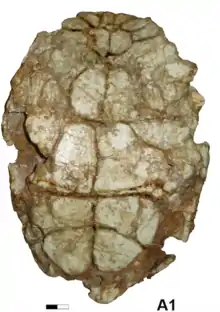Testudo hellenica
Testudo hellenica is an extinct genus of tortoise of the genus Testudo from the Miocene (Vallesian) Nea Messimvria Formation (Zone MN 10) of Greece.[1] T. hellenica is the earliest known crown-Testudo from Greece (according to Garcia et al., 2020), since the next oldest Testudo species, T. marmorum, from Greece come from the Turolian (7.3-7.2 ma) Pikermi beds.[1][2][3]
| Testudo hellenica | |
|---|---|
 | |
| Holotype carapace LGPUT RPI-216 | |
| Scientific classification | |
| Kingdom: | Animalia |
| Phylum: | Chordata |
| Class: | Reptilia |
| Order: | Testudines |
| Suborder: | Cryptodira |
| Superfamily: | Testudinoidea |
| Family: | Testudinidae |
| Genus: | Testudo |
| Species: | T. hellenica |
| Binomial name | |
| Testudo hellenica Garcia et al., 2020 | |
T. hellenica is important for understanding the radiation of the evolutionary history of the lineage of the Testudo genus, pushing it back from 7 Ma (2017)[2] and 8 Ma (2018)[4] to 9.1-9 Ma (2020).[1]
Discovery and naming
The holotype, a carapace with a preserved plastron, was discovered c.1983 in the Ravin de la Pluie, Axios Valley from fossil sediments ranging from 9.149-9.046 Ma, although the formation may be as old as 11.608 Ma and as recent as 8.7 Ma.[5][6][7] In order to observe the detail of the carapace, the specimen was completely prepared. The phylogeny of T. hellenica was studied in 2016, although it was unnamed at the time.[8] The species Testudo hellenica was named in 2020.[1]
The holotype, LGPUT RPI-216, preserves a carapace, plastron and several bones underneath, including a fused humerus and scapula.[1][5]
Description
The carapace is approximately 22.8 centimetres (9.0 in) long, meaning that when fully grown, it would have been around 1 metre (3.3 ft) long.[1] The rounded anterior lobe is 55.8 millimetres (2.20 in) long, while the posterior lobe is 66.1 millimetres (2.60 in) long. The bridge between the two lobes is 102.7 millimetres (4.04 in) long.[1] Since the domed pygal plate curves inwards, this indicates that the holotype individual was a male. Testudo hellenica shares with Eurotestudo, T. marginata and T. marmorum an elongated shell, although the plastron of the holotype of T. marmorum is different to that of T. hellenica.[1][9]
References
- Géraldine Garcia; Aurélie Pinton; Xavier Valentin; Dimitris S. Kostopoulos; Gildas Merceron; Louis de Bonis; George D. Koufos (2020). "The earliest known crown-Testudo tortoise from the late Miocene (Vallesian, 9 Ma) of Greece". PLoS ONE. 15 (4): e0224783. doi:10.1371/journal.pone.0224783. PMC 7141670. PMID 32267839.
- Böhme M, Spassov N, Ebner M, Geraads D, Hristova L, Kirscher U, et al (2017) Messinian age and savannah environment of the possible hominin ”Graecopithecus” from Europe. Plos one: https://doi.org/10.1371/journal.pone.0177347.
- Gaudry A (1862) Note sur les débris d’Oiseaux et de Reptiles trouvés à Pikermi, Grèce, suivie de quelques remarques de paléontologie générale. Bulletin de la Société Géologique de France 19: 629–640.
- Vlachos E, Rabi M (2018) Total evidence analysis and body size evolution of extant and extinct tortoises (Testudines: Cryptodira: Pan-Testudinidae). Cladistics 34:652–683.
- Bour R (1983) Les tortues terrestres du Palarctique. In Beaufort F. de (ed.), Espèces menacées et exploitées dans le monde. Guide pratique pour leur connaissance et leur identification. Secrétariat de la Faune et de la Flore, Paris, pp. 1–11.
- Bonis L de, Bouvrain G., Koufos GD (1988) Late Miocene mammal localities of the lower Axios valley (Macedonia, Greece) and their stratigraphic significance. Modern Geology 13: 141–147.
- Koufos GD (2013) Neogene mammal biostratigraphy and chronology of Greece. In Wang X., Flynn L.J. and Fortelius M. (eds), Fossil mammals of Asia, Neogene biostratigraphy and chronology. Columbia University Press, New York, pp. 595–621.
- Lujan AH, Delfino M, Robles JM, Alba DM (2016). The Miocene tortoise Testudo catalaunica Bataller, 1926 and a revised phylogeny of extinct species of genus Testudo (Testudines: Testudinidae). Zoological Journal of the Linnean Society
- Lapparent de Broin F de, Bour R, Perälä JF (2006a) Morphological definition of Eurotestudo (Testudinidae, Chelonii): First part. Annales de Paléontologie 92 (3): 255–304.
